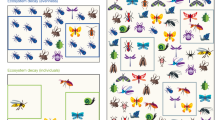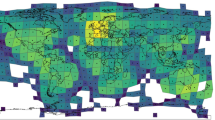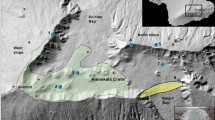Abstract
Arising from F. He & S. P. Hubbell Nature 473, 368–371 (2011)10.1038/nature09985.
He and Hubbell developed a sampling theory for the species–area relationship (SAR) and the endemics–area relationship (EAR)1. They argued that the number of extinctions after habitat loss is described by the EAR and that extinction rates in previous studies are overestimates because the EAR is always lower than the SAR. Here we show that their conclusion is not general and depends on the geometry of habitat destruction and the scale of the SAR. We also question their critique of the Millennium Ecosystem Assessment estimates, as those estimates are not dependent on the SAR only, although important uncertainties remain due to other methodological issues.
This is a preview of subscription content, access via your institution
Access options
Subscribe to this journal
Receive 51 print issues and online access
$199.00 per year
only $3.90 per issue
Buy this article
- Purchase on Springer Link
- Instant access to full article PDF
Prices may be subject to local taxes which are calculated during checkout


Similar content being viewed by others
References
He, F. & Hubbell, S. P. Species–area relationships always overestimate extinction rates from habitat loss. Nature 473, 368–371 (2011)
van Vuuren, D., Sala, O. & Pereira, H. M. The future of vascular plant diversity under four global scenarios. Ecol. Soc. 11, 25 (2006)
Pimm, S. L., Russell, G. J., Gittleman, J. L. & Brooks, T. M. The future of biodiversity. Science 269, 347–350 (1995)
Reid, W. V. in Tropical Deforestation and Species Extinction (eds Whitmore, T. C. & Sayer, J. A. ) 53–73 (Chapman and Hall, 1992)
Kinzig, A. & Harte, J. Implications of endemics–area relationships for estimates of species extinctions. Ecology 81, 3305–3311 (2000)
Rosenzweig, M. L. Loss of speciation rate will impoverish future diversity. Proc. Natl Acad. Sci. USA 98, 5404–5410 (2001)
Dengler, J. Which function describes the species–area relationship best? A review and empirical evaluation. J. Biogeogr. 36, 728–744 (2009)
Pereira, H. M. & Daily, G. C. Modeling biodiversity dynamics in countryside landscapes. Ecology 87, 1877–1885 (2006)
Mace, G. M. et al. in Ecosystems and Human Well-being: Current States and Trends 77–126 (Millennium Ecosystem Assessment, 2005)
Mace, G. M. & Kunin, W. Classifying threatened species—means and ends. Phil. Trans. R. Soc. B 344, 91–97 (1994)
Smith, F. D. M., May, R. M., Pellew, R., Johnson, T. H. & Walter, K. S. Estimating extinction rates. Nature 364, 494–496 (1993)
Pereira, H. M. et al. Scenarios for global biodiversity in the 21st century. Science 330, 1496–1501 (2010)
Jetz, W., Wilcove, D. S. & Dobson, A. P. Projected impacts of climate and land-use change on the global diversity of birds. PLoS Biol. 5, e157 (2007)
Sinervo, B. et al. Erosion of lizard diversity by climate change and altered thermal niches. Science 328, 894–899 (2010)
Sekercioglu, C. H., Schneider, S. H., Fay, J. P. & Loarie, S. R. Climate change, elevational range shifts, and bird extinctions. Conserv. Biol. 22, 140–150 (2008)
Author information
Authors and Affiliations
Contributions
All authors participated in the discussion of the ideas that resulted in this paper. H.M.P. wrote the paper, L.B.-d.-A. performed the data analysis, and I.S.M. prepared the data sets for analysis.
Corresponding author
Ethics declarations
Competing interests
Declared none.
PowerPoint slides
Rights and permissions
About this article
Cite this article
Pereira, H., Borda-de-Água, L. & Martins, I. Geometry and scale in species–area relationships. Nature 482, E3–E4 (2012). https://doi.org/10.1038/nature10857
Received:
Accepted:
Published:
Issue Date:
DOI: https://doi.org/10.1038/nature10857
This article is cited by
-
Ecosystem services and biodiversity appraisals by means of life cycle tools: state-of-art in agri-food and forestry field
Agriculture & Food Security (2023)
-
Countryside Biogeography: the Controls of Species Distributions in Human-Dominated Landscapes
Current Landscape Ecology Reports (2019)
-
Dispersal ability determines the scaling properties of species abundance distributions: a case study using arthropods from the Azores
Scientific Reports (2017)
-
Improving extinction projections across scales and habitats using the countryside species-area relationship
Scientific Reports (2017)
-
Mapping functional diversity from remotely sensed morphological and physiological forest traits
Nature Communications (2017)
Comments
By submitting a comment you agree to abide by our Terms and Community Guidelines. If you find something abusive or that does not comply with our terms or guidelines please flag it as inappropriate.



